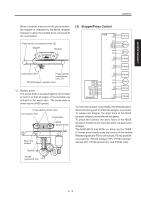HP Color 9850mfp Service Manual - Page 505
Operation, Signals, M101_F/R Finisher to TUDB to M101
 |
View all HP Color 9850mfp manuals
Add to My Manuals
Save this manual to your list of manuals |
Page 505 highlights
2 UNIT EXPLANATION Q3224A 1. Operation There are two types of conveyance operations: entrance and ejected booklet conveyance. These conveyance operations differ between the trim mode (booklet is cut) and the through mode (booklet is not cut). a. Entrance conveyance (1) Trim mode When the M20 (folding conveyance) of the finisher is turned ON, the M101(conveyance) is turned ON to convey the booklet ejected from the finisher to the entrance conveyance section at a speed of 580 mm/s. The M101 turns OFF to stop conveying the booklet when the specified time lapses after the PS102 (conveyance) provided in the press section is turned ON by detecting the leading edge ( folding edge) of the booklet. The folding edge of the booklet is pressed against the stopper provided in the press section, allowing the booklet to be trimming. (2) Through mode The M101 is turned ON at the same timing as in the trim mode. In the through mode, booklet conveyance does not stop temporarily for trimming; ejected booklet conveyance starts without turning OFF the M101. b. Ejected booklet conveyance (1) Trim mode When the M105(press) stops pressing the press plate after the completion of trimming, the M101 turns ON again to convey the trimmed booklet toward the stacker section and eject it. When the PS108 (exit) provided at the entrance of the holder section is turned OFF by detecting the trailing edge (trim edge) of the conveyed booklet, the M101 turns OFF to stop conveying the booklet, allowing the next booklet to be conveyed. (2) Through mode The M101 is held ON from the moment the booklet enters the entrance conveyance section to the moment it reaches the stacker section. The M101 is turned OFF at the same timing as in the trim mode. 2. Signals a. Input signals (1) PS102_SIG (PS102 to TUDB to finisher) This signal is used to detect a conveyed booklet in the press section. [L]: Booklet exists. [H]: Booklet does not exist. (2) PS108_SIG (PS108 to TUDB to finisher) This signal is used to detect ejection of a booklet at the entrance of the holder section. [L]: Booklet exists. [H]: Booklet does not exist. (3) M101_PLL (M101 to TUDB to finisher) M101 rotation monitoring signal [L]: Stopped or locked [H]: Rotaing at the specified speed (4) M105_CONT (Finisher to TUDB) M105 ON/OFF control signal. [L]: M105 ON [H]: M105 OFF b. Output signals (1) M101_CONT (Finisher to TUDB to M101) M101 ON/OFF control signal. [L]: M101 ON [H]: M101 OFF (2) M101_CLK (Finisher to TUDB to M101) This is a reference clock signal used to perform PLL control over the M101. (3) M101_F/R (Finisher to TUDB to M101) M101 rotational direction change signal. [L]: Reverse [H]: Forward (4) M101_BLK (Finisher to TUDB to M101) M101 brake signal. [L]: Brake ON [H]: Brake OFF 2 - 3















